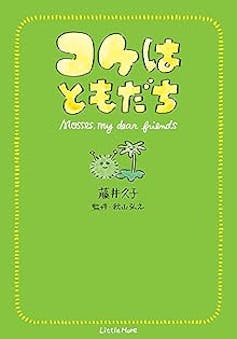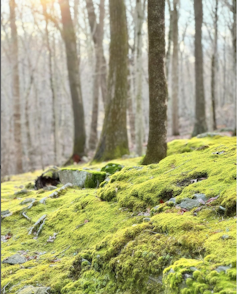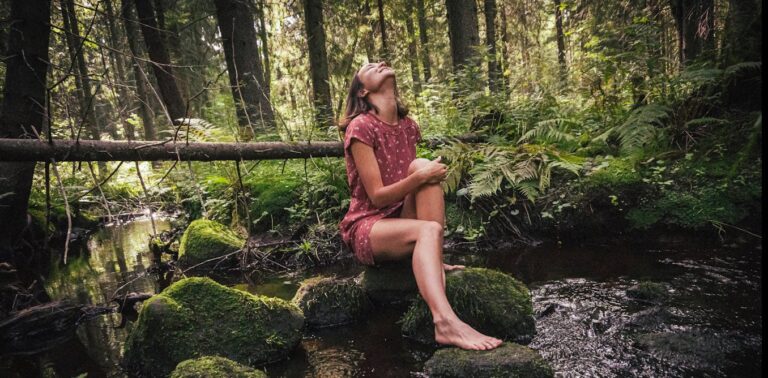On TikTok and Instagram, people appear as “Moss Girls” lying on the forest floor, gazing up at the leafy canopy and caressing the moss. The US National Forest Foundation has also borrowed the term, launching an Instagram account in 2024. Moss Girls recognize the need to step away from the pressures of modern urban life and advocate spending time in nature as a means of recovery.
The rapid pace and pressures of neoliberal capitalism take a huge toll not only on individual well-being, but on the well-being of societies and the planet as a whole. These pressures are felt most keenly by women, whose work remains largely undervalued and underpaid, and young people who are often shut out of the housing market and in precarious jobs. Yet they are still bombarded on social media with images of unattainable success. Moss selfies are not one of them.

National Forest Park/Instagram
The pressures to be successful, to be a “girlboss” at work, and to be the perfect girlfriend, wife, mother, and daughter take a toll on women’s physical and mental health. So it’s no wonder women are moving from girlbossing to girlmoshing, another destructive form of rest and seclusion that focuses on being intentionally “unproductive” at home.
While the origins and scope of this aesthetic movement are difficult to pin down, “girl mossing,” “girl rotting,” and other related terms have increased significantly on social media since the middle of last year. The trend was first described by journalist and influencer Daisy Alioto She tweeted: “Girl Boss is dead, long live Girl Moss (lying on the forest floor and being reabsorbed by nature).”
Her tweet was picked up by other influencers and the word spread across lifestyle and wellness blogs and popular media.

Grace Siddhi/Instagram
There are parallels between moss girls, as a byword for resting and relaxing in nature, and the global trend of literally appreciating moss, which is also related to relaxing in nature. Moss has long been a national craze in Japan, in part due to the smash-hit 2011 book Moss, My Dear Friend. The term “moss girl” in Japanese, or #mossgirl or #mossgirls, has 4,036 posts on Instagram.
On Facebook, the Moss Appreciation Society has over 267,100 members, and there are Instagram accounts dedicated to moss photography, such as Mossgirlny, with 14,900 followers.

Moss isn’t fast moving, it’s soft and fluffy which makes it perfect for burrowing into the soil and nourishing the soil health, holding on to vital nutrients, preventing erosion and helping to ward off disease, it also aids in decomposition, turning decaying leaves into new life.
In Japan, “moss girl” retreats come with moss-discovery tours and specially themed desserts. The moss craze continues to this day, with Oprah Winfrey recently joining the trend, visiting the moss gardens of Saihoji Temple for some “forest bathing.”
Rest, repair and do nothing
The Girl’s Moss phenomenon is also evidence of the growing popularity of what scholars call Dark Green Religion, Devout Naturalism, or Relational Naturalism. A strong connection to nature and a recognition of our interdependence with nature is becoming a prevalent worldview and source of meaning for many people. It can have a spiritual dimension or be entirely materialistic and scientific.
This connection to nature is often associated with a desire for rest and restoration, in contrast to (and symbolizing recovery from) the speed of capitalist, hustling culture.
Trends like Girl Moss and Girl Lotting fall in line with the current trend of quietly quitting work, growing interest in the Dutch concept of nixen (doing nothing), and Dzogchen Buddhist emphasis on easy, peaceful rest.
There has been a simultaneous rise in “tangping” (prostration) among young Chinese who are rejecting high-pressure jobs in search of a “less-pressure life,” as well as a rise in “voluntary withdrawal” and “letting things go” from the pursuit of goals that are deemed “too difficult to achieve.”
Notably, these trends have emerged as we return to the productivity culture of modern working life after the COVID-19 lockdowns that forced economic slowdowns in many parts of the world. Perhaps we have learned the wisdom of letting things gather moss and rot.
Pema Chodron, a Buddhist nun and best-selling author, says that things “come together and fall apart” over and over again. “And that’s exactly what it feels like.”
The Western capitalist mindset, shaped by Protestant values, emphasizes “getting things together.” We typically seek material rewards by working hard and achieve success by taking action.
We celebrate the “wins” of a promotion, a new house, a marriage, the birth of a child, etc. In contrast, we truly suffer when things inevitably fall apart, such as when we face old age, illness, and death—human decline.

mossgirlny/Instagram
The tendency to grow moss and rot is not the first spiritual or lifestyle movement to subvert the prescribed capitalist path of life.
In the 1960s, counterculture leader and psychedelic advocate Timothy Leary urged young people to “tune in, turn on, and drop out,” but Girl Moth and Girl Rotting are distinct in that they are led by young women and embrace the natural rhythm of decline.
Both resist the hustle and bustle of productivity culture through the recognition that humans are part of nature and therefore subject to natural cycles, which fundamentally involve decomposition.
In this respect, she overlaps with women leading the natural death and home burial movements, such as the writer Caitlin Doughty, who advocate for embracing decay and “the freedom found in decay, the mess, the chaos, the rawness of a dead body.” And for advocates of new methods of disposing of bodies, like composting, decay is a fundamentally generative act, one that gives rise to new life.
We cannot simply produce and consume in rapid succession: to be healthy we need to rest, decay, rejuvenate, and eventually die a good death.
This article is part of the “Religion and Spirituality” series, which has emerged from the Australian Spirituality Discovery Project, funded by the Australian Research Council and led by academics at Deakin University. The series explores the so-called growing interest in spirituality in Australia and how it relates to well-being and risk.

